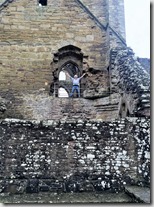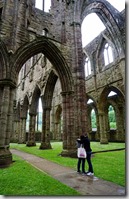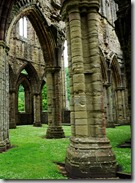 The River Wye flows through a rugged cleft heavily forested, in southeastern Wales. Literally inhabited for millennia, with cave artifacts dating back 12,000 years to Paleolithic times, the valley was also a medieval religious centre and a modern industrial complex. Abundant timber for charcoal and cascading rivers for power supported iron kilns, copper and paperworks, along the length of the navigable river. Industrial development went into decline a century ago, and the area is re-forested today to become an Area of Outstanding Natural Beauty.
The River Wye flows through a rugged cleft heavily forested, in southeastern Wales. Literally inhabited for millennia, with cave artifacts dating back 12,000 years to Paleolithic times, the valley was also a medieval religious centre and a modern industrial complex. Abundant timber for charcoal and cascading rivers for power supported iron kilns, copper and paperworks, along the length of the navigable river. Industrial development went into decline a century ago, and the area is re-forested today to become an Area of Outstanding Natural Beauty.
The main road leads up from the south along the River, winding beneath steep cliffs and through small villages. The best of these is Tintern, once site of a shallow ford and later the host of a vast abbey raised along the banks. Established in 1131 as a Cistercian retreat, the monks emphasized manual labour and self-sufficiency, agriculture and ales. Their abbeys similarly embodied utilitarian order and gothic simplicity, unadorned arches and pillars.
Today, Tintern Abbey is a shell, only the walls and pillars remaining. But the remains tower over the brassy meadows within, arches and windows largely intact, catching the light and framing the forests. it’s amazing to walk through, the stone arches intersecting far overhead, the monk’s stairs leading up the walls.
I found the minutia of the place most interesting. The stone segments of the walls and pillars are mortared together, stone glue holding for 700 years. The shorter walls have a matrix of pebbles and clay, almost a coarse concrete, several inches thick. The main supports for the vaults have much thinner seams, as might be expected for the great weight that they bear.
The surprise is the shale-like stone embedded in the mortar. It cant be very sturdy, yet it’s everywhere in the main nave. I wonder if it isn’t a shim, intended to level the stones, rather than a structural element. Amazing, though, that it still remains: I always think of shale as brittle and crumbling.
 The northern reaches of the valley, where the walls open and there are larger towns and farms, isn’t as interesting generally as the southern part. The exception is Ross-on-Wye, if only for the ubiquitous presence of the Man of Ross-on-Wye throughout the town.
The northern reaches of the valley, where the walls open and there are larger towns and farms, isn’t as interesting generally as the southern part. The exception is Ross-on-Wye, if only for the ubiquitous presence of the Man of Ross-on-Wye throughout the town.
John Kyrle, a bachelor of modest living and charitable deeds, arrived in the mid-18800s. He committed himself to settling disputes, supporting the schools, tending the sick, helping the poor, beautifying the town, and preserving its landscapes.
‘rare philanthropy then, moreso today.












